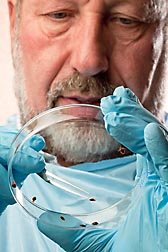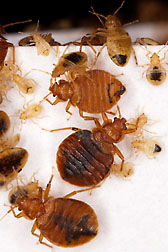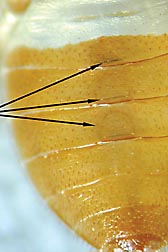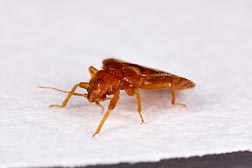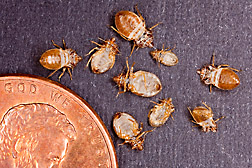Identifying Compounds To Help Control Bed Bugs
When planning an attack on bothersome pests, it’s a good idea to know your enemies, especially if they happen to be bed bugs. These small, flat, blood-feeding insects—an uncommon problem since the 1950s—have once again become a menace in homes, apartments, hotels, shelters, and even places of work in the last 10 years.
Despite extensive efforts to determine whether bed bugs transmit disease-causing pathogens, no evidence indicates that they are a problem other than their biting, blood feeding, and dirty habits. However, some people have severe reactions to bed bug bites, and getting rid of the insects can be costly. Problems often go unnoticed until bug populations increase substantially.
As part of a strategic plan to control bed bugs, scientists at the ARS Henry A. Wallace Beltsville [Maryland] Agricultural Research Center are learning more about bed bug behavior and stepping up their efforts to develop substances that can be used to control them and other biting arthropods and urban pests.
While the main thrust of the research is to discover and develop new chemicals for bed bug control, entomologist Mark Feldlaufer, chemist Kamlesh Chauhan, and retired ARS entomologist Jeffrey Aldrich also focused on compounds that affect bed bug behavior.
|
|
Alarming Behavior
“Both adult and immature bed bugs produce defensive compounds referred to as ‘alarm pheromones,’” says Feldlaufer, who works at the Invasive Insect Biocontrol and Behavior Laboratory in Beltsville. “When released, alarm pheromones cause aggregated bed bugs to disperse.”
In one study, scientists identified two new alarm pheromones—4-oxo-hexenal and 4-oxo-octenal—from immature bed bugs. A Swedish research group has since identified these compounds from a related species, the tropical bed bug, and shown that the compounds are biologically active, Feldlaufer says.
“Alarm pheromones, in general, may have utility in bed bug management programs by causing these otherwise cryptic insects to disperse and thereby increasing the likelihood of contact with an insecticide or other control agent,” Feldlaufer says.
For these identifications, scientists collected the cast skins, which retain chemicals from the bed bug’s scent glands, at specific stages. They then used gas chromatography and mass spectrometry technology to analyze and identify the compounds in the glands.
Mass spectrometry also was used in recent research by Feldlaufer, in collaboration with biochemistry professor Gary Blomquist at the University of Nevada-Reno, to identify 17 compounds associated with the outer protective layer of the cuticle, referred to as “cuticular hydrocarbons.” These compounds may play an important role in the bed bug behavior of aggregation, Feldlaufer says.
|
|
Sniffing Out Bugs
Scientists are also interested in what role these cuticular compounds—along with the alarm pheromones—play in canine detection of bed bugs.
“Using dogs trained to detect bed bug infestations is an emerging industry, and a better understanding of the chemical basis of canine detection will hopefully contribute to a harmonization of training and detection methods,” Feldlaufer says. “This research will ultimately benefit the public by providing a straightforward and reliable means of early detection of bed bug infestations.”—By Sandra Avant, Agricultural Research Service Information Staff.
|
|
This research is part of Veterinary, Medical, and Urban Entomology, an ARS national program (#104) described at www.nps.ars.usda.gov.
Mark Feldlaufer is with the USDA-ARS Invasive Insect Biocontrol and Behavior Laboratory, 10300 Baltimore Ave., Bldg. 1040, Beltsville, MD 20705-2350; (301) 504-5413.
"Identifying Compounds To Help Control Bed Bugs" was published in the February 2013 issue of Agricultural Research magazine.







